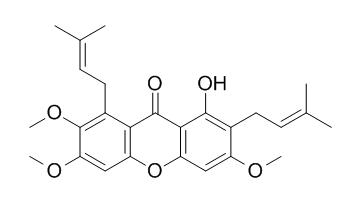Fuscaxanthone C
Fuscaxanthone C is a natural product from Garcinia mangostana.
Inquire / Order:
manager@chemfaces.com
Technical Inquiries:
service@chemfaces.com
Tel:
+86-27-84237783
Fax:
+86-27-84254680
Address:
1 Building, No. 83, CheCheng Rd., Wuhan Economic and Technological Development Zone, Wuhan, Hubei 430056, PRC
Providing storage is as stated on the product vial and the vial is kept tightly sealed, the product can be stored for up to
24 months(2-8C).
Wherever possible, you should prepare and use solutions on the same day. However, if you need to make up stock solutions in advance, we recommend that you store the solution as aliquots in tightly sealed vials at -20C. Generally, these will be useable for up to two weeks. Before use, and prior to opening the vial we recommend that you allow your product to equilibrate to room temperature for at least 1 hour.
Need more advice on solubility, usage and handling? Please email to: service@chemfaces.com
The packaging of the product may have turned upside down during transportation, resulting in the natural compounds adhering to the neck or cap of the vial. take the vial out of its packaging and gently shake to let the compounds fall to the bottom of the vial. for liquid products, centrifuge at 200-500 RPM to gather the liquid at the bottom of the vial. try to avoid loss or contamination during handling.
Foods.2023, 12(6):1227.
Molecules.2024, 29(5):1048.
J Ethnopharmacol.2023, 321:117501.
Kyung Hee University2024, rs-3888374
LWT2021, 147:111620.
J Ethnopharmacol.2022, 282:114574.
Food Chem.2022, 378:131975.
Biochem Biophys Res Commun.2018, 505(4):1148-1153
Int J Mol Sci.2023, 24(18):14077.
Journal of Pharmaceutical Investigation2024, 024-00662-1.
Related and Featured Products
Planta Med. 2005 Feb;71(2):181-3.
Cytotoxic constituents from Cratoxylum arborescens.[Pubmed:
15729629 ]
A new natural xanthone, 1,3-dihydroxy-6,7-dimethoxy-2,8-diprenylxanthone, together with four known compounds, Fuscaxanthone C, 1,7-dihydroxyxanthone, 3-geranyloxy-6-methyl-1,8-dihydroxyanthraquinone and 2-geranylemodin were isolated from the stem bark of Cratoxylum arborescens (Vahl) Blume.
METHODS AND RESULTS:
The structure elucidations were achieved through spectroscopic analyses. Compounds 1 and 5 showed moderate activity against the human small cell lung cancer NCI-H187 cell line with the IC50 values of 3.69 +/- 1.27 microg/mL and 3.08 +/- 0.73 microg/mL, respectively.
Research Journal of Chemistry & Environment, 2011 , 15 (2) :62-66.
α-mangostin and β-mangostin from Cratoxylum glaucum[Reference:
WebLink]
Our continuing interest in xanthones and anthraquinones from the Cratoxylum genus has led us to look at Cratoxylum glaucum. This resulted in the isolation of α-mangostin (1), β-mangostin (2), Fuscaxanthone C (3), 3-geranyloxy-6-methyl-l, 8-dihydroxyanthraquinone (4), β-sitosterol (5), 1, 8-dihydroxy-3-methoxy-6-methylanthraquinone (6), stigmasterol (7), friedelin (8) and betulinic acid (9).
METHODS AND RESULTS:
Structural elucidations of these compounds were achieved by using ID and 2D NMR spectroscopic experiments. Cytotoxic assays indicated that the hexane and ethyl acetate extracts demonstrated cytotoxicity against the MCF7 cancer cell line. Meanwhile, the ethyl acetate and methanol extracts of C. glaucum inhibited the HL-60 cancer cell line activity.



